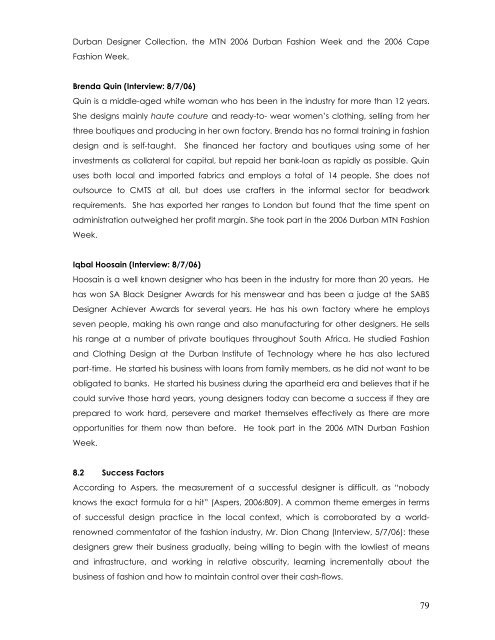Create successful ePaper yourself
Turn your PDF publications into a flip-book with our unique Google optimized e-Paper software.
Durban Designer Collection, the MTN 2006 Durban Fashion Week and the 2006 Cape<br />
Fashion Week.<br />
Brenda Quin (Interview: 8/7/06)<br />
Quin is a middle-aged white woman who has been in the industry for more than 12 years.<br />
She designs mainly haute couture and ready-to- wear women’s clothing, selling from her<br />
three boutiques and producing in her own factory. Brenda has no formal training in fashion<br />
design and is self-taught. She financed her factory and boutiques using some of her<br />
investments as collateral for capital, but repaid her bank-loan as rapidly as possible. Quin<br />
uses both local and imported fabrics and employs a total of 14 people. She does not<br />
outsource to CMTS at all, but does use crafters in the informal sector for beadwork<br />
requirements. She has exported her ranges to London but found that the time spent on<br />
administration outweighed her profit margin. She took part in the 2006 Durban MTN Fashion<br />
Week.<br />
Iqbal Hoosain (Interview: 8/7/06)<br />
Hoosain is a well known designer who has been in the industry for more than 20 years. He<br />
has won SA Black Designer Awards for his menswear and has been a judge at the SABS<br />
Designer Achiever Awards for several years. He has his own factory where he employs<br />
seven people, making his own range and also manufacturing for other designers. He sells<br />
his range at a number of private boutiques throughout South Africa. He studied Fashion<br />
and Clothing Design at the Durban Institute of Technology where he has also lectured<br />
part-time. He started his business with loans from family members, as he did not want to be<br />
obligated to banks. He started his business during the apartheid era and believes that if he<br />
could survive those hard years, young designers today can become a success if they are<br />
prepared to work hard, persevere and market themselves effectively as there are more<br />
opportunities for them now than before. He took part in the 2006 MTN Durban Fashion<br />
Week.<br />
8.2 Success Factors<br />
According to Aspers, the measurement of a successful designer is difficult, as “nobody<br />
knows the exact formula for a hit” (Aspers, 2006:809). A common theme emerges in terms<br />
of successful design practice in the local context, which is corroborated by a world-<br />
renowned commentator of the fashion industry, Mr. Dion Chang (Interview, 5/7/06): these<br />
designers grew their business gradually, being willing to begin with the lowliest of means<br />
and infrastructure, and working in relative obscurity, learning incrementally about the<br />
business of fashion and how to maintain control over their cash-flows.<br />
79
















